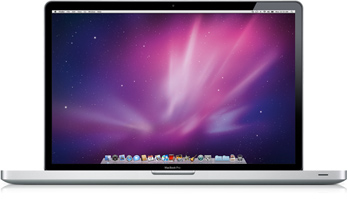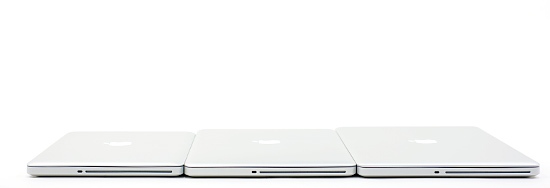Done for 2009: The Holiday MacBook Pro Roundup
by Anand Lal Shimpi on November 10, 2009 12:00 AM EST- Posted in
- Mac
And The Story Begins
Traditionally the notebooks with the largest screens are the least attractive, have the worst battery life and are heavy. They're also usually cheaper than their smaller brethren to give people a reason to buy them.
Take a look at what Dell and HP offer with a 17-inch screensize:
| 17.3-inch Notebooks | Dell Studio 17 | HP Pavillion dv7t Quad Edition |
| CPU | Intel Core i7 720QM (1.6GHz, up to 2.8GHz Turbo) | Intel Core i7 720QM (1.6GHz, up to 2.8GHz Turbo) |
| Memory | 4GB DDR3-1066 | 4GB DDR3-1066 |
| HDD | 250GB 7200RPM | 320GB 7200RPM |
| Video | ATI Mobility Radeon HD 4650 1GB | NVIDIA GeForce GT 230M 1GB |
| Optical Drive | 8X Slot Load DL DVD +/-R | 8X Slot Load DL DVD +/-R |
| Screen Resolution | 1600 x 900 | 1600 x 900 |
| Battery | 9-cell 85Whr | 8-cell ??WHr |
| Dimensions (W x D x H) | 16.28" x 11.04" x 1.1" - 1.54" | 16.2" x 10.9" x 1.37" - 1.70" |
| Weight | 7.08 lbs (6-cell battery) | 7.74 lbs |
| Price | $1099 | $1069.99 |
In both cases you're looking at over 1" thick at the thinnest point, and in the case of the HP system it goes up to 1.7" thick. Both machines start at 7 lbs and don't offer higher than 1080p resolutions. In fact, all the larger screen is useful for is reducing DPI as you can get the same resolution screen in 15-inch and 16" models. The hardware is usually fast and affordable, both machines cost less than $1000.
The 17-inch MacBook Pro is a bit different.

At 0.98" thick, it's only 0.03" thicker than the 13-inch or 15-inch MacBook Pro. And that's a constant thickness from front to back. The impact on how it feels is tremendous. It's the first 17-inch notebook I've used that doesn't make me want to laugh at first sight. It honestly just looks and feels like a slightly bigger 15-inch machine.
| 17.3-inch Notebooks | Apple 17-inch MacBook Pro | HP Pavillion dv7t Quad Edition |
| CPU | Intel Core 2 Duo 2.8GHz | Intel Core i7 720QM (1.6GHz, up to 2.8GHz Turbo) |
| Memory | 4GB DDR3-1066 | 4GB DDR3-1066 |
| HDD | 500GB 5400RPM | 320GB 7200RPM |
| Video | NVIDIA GeForce 9400M (integrated) + NVIDIA GeForce 9600M 512MB (discrete) | NVIDIA GeForce GT 230M 1GB |
| Optical Drive | 8X Slot Load DL DVD +/-R | 8X Slot Load DL DVD +/-R |
| Screen Resolution | 1920 x 1200 | 1600 x 900 |
| Battery | 95Whr | 8-cell ??WHr |
| Dimensions (W x D x H) | 15.47" x 10.51" x 0.98" | 16.2" x 10.9" x 1.37" - 1.70" |
| Weight | 6.6 lbs | 7.74 lbs |
| Price | $2499 | $1069.99 |
It’s also Apple’s most expensive notebook. Starting at $2499, it’s more expensive than the 27” iMac and doesn’t even come with a quad-core processor. You’re paying for the screen size, as you can get the same hardware in the 15” MacBook Pro.
The added size is used for one purpose: a higher screen resolution. Apple offers a single display option with the 17-inch machine: a native 1920 x 1200 panel. It's a 16:10 aspect ratio panel, measuring 17-inch on the diagonal, resulting in a pixel density of 133.2 pixels per inch (PPI).
| 17.3-inch Notebooks | Pixels per Inch |
| Apple 13-inch MacBook Pro | 113.5 |
| Apple 15-inch MacBook Pro | 101.6 |
| Apple 17-inch MacBook Pro | 133.2 |
| Apple 27-inch iMac | 108.8 |
| Apple 30-inch Cinema Display | 101.6 |
| 15-inch 1080p Panel | 141.2 |
That’s more than a 30” display. That's more than the 27" iMac. That's more than any other 17-inch notebook on the market today. Only the 15-inch 1080p panels offer a higher pixel density at 141.2 PPI. It's sharp.
Apple makes the 17-inch MacBook Pro very work-focused, you get a ton of desktop space in a package that's honestly not bulky. I can't stress how pleasant it is to carry around; at a constant thickness of less than 1" it really feels a lot smaller than it is. It's the only 17-inch notebook I'd be willing to take with me.

From left to right: 13-inch, 15-inch, 17-inch MacBook Pro. Note the constant height.
The 17-inch MacBook Pro was the first to use Apple's integrated batteries out of necessity. Apple wanted to build a slim, attractive 17-inch MacBook Pro, and cutting down on battery volume enabled that. A side effect was that the 17-inch model has impressive battery life.
Paired with a 95Whr battery, Apple promised up to 8 hours of battery life - a realistically attainable figure as you'll soon see.
From a hardware perspective the 17” isn’t that much different from the rest of the lineup. The system starts with a NVIDIA GeForce 9400M chipset, adds a separate GeForce 9600M for GPU intensive workloads (3D games, OpenCL apps, etc...) and gives you the option of either a 2.8GHz or 3.06GHz 45nm Core 2 Duo with a 6MB L2 cache. The vast majority of users will find the 9400M is sufficient for their needs. And paired with Snow Leopard, the 9600M in the off state doesn’t sap as much battery power as it did under Leopard.
The machine starts with 4GB of memory, expandable up to 8, and comes with a 500GB 5400RPM SATA drive. SSDs are still only optional from Apple.
The 17” system doesn’t come with an integrated SD card reader but it is the only MacBook Pro to ship with an ExpressCard/34 slot.

From left to right: Power input, Ethernet, FireWire 800, 3 USB, Mini DisplayPort, Line In, Headphone Out, ExpressCard/34
Mini DisplayPort is the only way to connect to an external display, and unfortunately Apple cheeps out and doesn't supply any adapters with the machine. With a 17-inch 1920 x 1200 panel, you'll probably be fine without one though.
About the only thing that the machine is missing is Nehalem, but that won't come until next year.

From left to right: 13-inch, 15-inch and 17-inch MacBook Pro
The 17” MacBook Pro started a new trend within Apple. Integrate the battery, offer longer battery life and no one will complain. The technology soon waterfalled down to the 15” and 13” models.










115 Comments
View All Comments
michael2k - Wednesday, November 11, 2009 - link
Yeah, if you mean "good code" like longer battery life in OS X than Windows?I mean, if you really believe that, buy a Mac, install Windows in VM, and get the hours of battery life of the Mac and the ability to run "good code" whenever you need it.
fitten - Wednesday, November 11, 2009 - link
You get all that battery life when you aren't actually doing anything with the machine (it's sitting idle). As the article says... start actually, you know, using the thing instead of having it as a fashion accessory and there isn't much difference.slashbinslashbash - Wednesday, November 11, 2009 - link
No, it's not "sitting idle." Anand got those times with Safari set to load a new page every 20 seconds, and iTunes playing music constantly. It is light usage, granted, but it's not sitting there doing nothing. Of course the CPU goes to an idle when it's not doing anything, and that's what makes the difference, because apparently Apple is handling this better than Microsoft.fitten - Wednesday, November 11, 2009 - link
Get an iPhone... mine does all that and more!darwinosx - Tuesday, November 10, 2009 - link
Apple doesn't know how to write code? Alllllrighty then...sprockkets - Tuesday, November 10, 2009 - link
God's don't talk to humans, even you Anand. So much for getting them to admit they are fallible.That being said, their 13" laptop is nice. Paying $2500 for a non i7 cpu isn't really a deal.
Oh, and if you are going to benchmark them, why not benchmark the Dell and HP while you are at it?
marraco - Sunday, November 15, 2009 - link
And something to add:This image on this article:
http://images.anandtech.com/reviews/mac/MacBookPro...">http://images.anandtech.com/reviews/mac/MacBookPro...
Shows why this line of obsolete hardware is not worth his 2.5X price:
You can't use them as portable computers, because reflections on each place don't let you see the screen. You only see reflections.
in the image we see the lights put to take the photos.
you can't go to a park and use the apples, because of reflections.
you see only your own face on bright days.
you can't focus on the screen, and soon get a headache.
of course, ANY laptop manufacturer knows that shinny screens are a health he11, and apple knows. But apple only care about taking the innocent consumer money. For the screen problem: pay to your doctor.
The0ne - Wednesday, November 11, 2009 - link
I'm also shocked, a bit, at how Anand loves his $2500 macbook :/ My fully spec'ed Vostro 17" ran me $800 with the Anand hot deal at the time. That's 3-4 times less than the macbook. Even being 2lbs more isn't going to justify spending that much on it.Sometimes even I don't understand why people prefer one product over even when it's at the extreme end. I love gadgets, I love designing, I love computing and I love retro-gaming but I think $2500 for a 17" laptop with "little" benefit over the competition is a bit much, especially here where most of us also use hot deals to help with our shopping.
The0ne - Wednesday, November 11, 2009 - link
replying to my post since I'm not at work and using my Vostro. Here's the spec on it...T7500, 4Gig, 320GB, 8400M, WUXGA, DVDRW, SD reader, webcam, wireless.
I have Windows 7 Ultimate running XP SP3 and Fedora under VMWare with no hiccups. How much versatility, power, performance does Anand really need? That is subjective, being my point. And as Anand pointed out 2GB of RAM is laughable meaning 4 would be nice and 8 is ideal. But trying getting 8GB without adding a few more hundred dollars to it the price. Mind you, this was 2 years ago to boot, although not much has changed in the offering :D
Sure it's a heavier at 2lbs more but I can live with that for 1/3 the price. Wouldn't I want it lighter? Of course, anyone would if they can afford the luxury. Would I like the extended battery life? Hell yea! But how many situations call for me to use the laptop in areas without an outlet? < 10%
I'm not sure why Anand didn't include the Vostro in 17" comparison. The WUXGA screen is extremely nice. And while the Apple might be nicer if I were to working in photo's and stuff it's barely needed for "writing." As Anand said, it's the increase in workspace that is the most important.
I'm not trying to bash the review. I think it's justified one one end but on the other it seems like Anand is all giddy with the new toy :) I know I would be too hahaha But I like to put things in perspective on price/performance.
BSMonitor - Wednesday, November 11, 2009 - link
Uhhh try reading the article..As a writer, light browsing, word documents, etc gets him around 7 - 8 hours without being stuck next to an outlet. You on the other would have to visit one 3-4 times in those 8 hours with your Vostro.